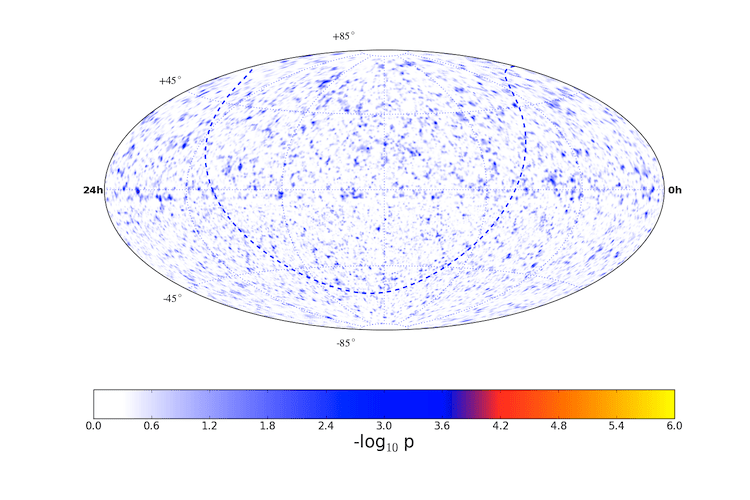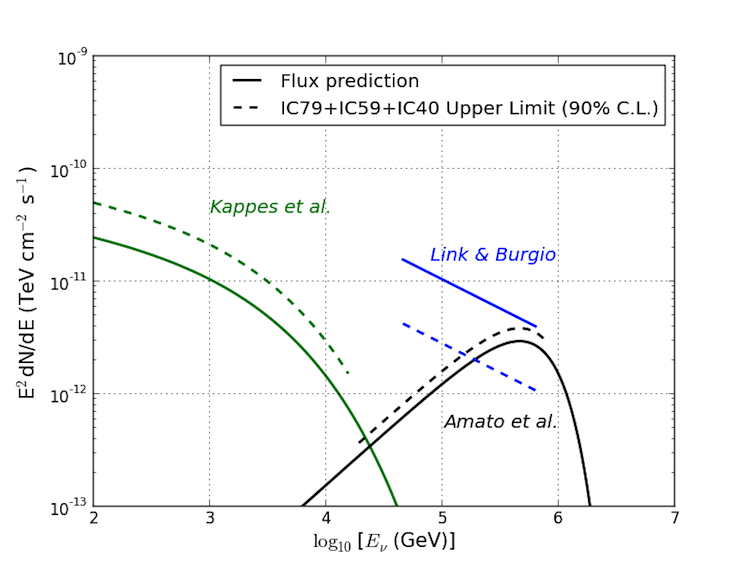Astrophysical neutrinos are produced in the same environments as cosmic rays and gamma rays. Highly energetic objects such as supernova remnant shocks, active galactic nuclei jets or gamma-ray bursts may thus be their sources. Neutrinos pointing back at any of these cosmic objects will serve as direct proof of hadronic particle acceleration since these neutrinos can only be produced by the interactions of protons or nuclei with ambient radiation or matter. Therefore, the detection of these neutrinos will unequivocally identify the sources of cosmic rays, which have to date remained a mystery.
However, astrophysical point sources have been shown to be overmodest, in terms of neutrino emission, in a new research study by the IceCube Collaboration. A search for neutrino point sources using throughgoing muons collected between April 2008 and May 2011 has not found any excess of neutrinos above the atmospheric background in any given direction in the sky. Neither did dedicated searches of a priori selected objects. However, the number of events collected so far and the performance of the detector allow IceCube to provide insights into the nature of cosmic ray sources even from non-discovery results. These results have been submitted today to The Astrophysical Journal.

Muon neutrino events in IceCube are used to search for point-like neutrino emission, since the secondary muons allow for a good directional reconstruction. “The long muon tracks are the best signature to reconstruct the direction of the incoming particle. At the energy range of this analysis, the muon is very well aligned with the primary neutrino. For energies above a few TeV, we can reconstruct the neutrino direction with a resolution of less than on degree,” explains Sirin Odrowski, an IceCube researcher at the University of Alberta.
Muons produced by the interaction of cosmic rays with the atmosphere are the main background. However, atmospheric muons will only reach the detector from above, since the Earth absorbs those coming from below. The downgoing muon background can be partially rejected by keeping only the most energetic events. Events with higher energy are more likely to have an astrophysical origin, while those with lower energy are more likely to be atmospheric neutrinos or muons.
The analysis presented here used an unbinned maximum likelihood ratio test, which calculates the significance of an excess of neutrinos over the atmospheric background taking into account both the directional information of the events and the energy. The atmospheric background estimate is taken from real data, reducing the impact of systematic uncertainties significantly.
Unlike traditional telescopes, IceCube can look at every direction in the sky at the same time, and the whole sky was searched for neutrino point sources. The collaboration also searched specifically for neutrino emission from selected catalogues of sources: 44 a priori selected objects with interesting observations in gamma rays or astrophysical modeling predicting neutrino emission; 6 Milagro TeV gamma-ray sources; 127 local starburst galaxies; 5 nearby clusters of galaxies; SNRs associated with molecular clouds; and galaxies with supermassive black holes.
None of the search results showed any significant excess in the neutrino fluxes observed by the IceCube detector. However, new constraints have been set for some models that predict astrophysical neutrino emissions.

The search for neutrino emission from the Crab Nebula (see previous figure) has led to interesting results. “The Crab Nebula is regularly used as a standard candle in gamma-ray astronomy. Our results show that the most optimistic hadronic models, which should explain both gamma-ray and neutrino emission from the Crab, are already ruled out and that IceCube’s sensitivity is getting close to the neutrino flux prediction for the rest of models,” says Juan Antonio Aguilar, from the University of Geneva and also a researcher at IceCube.
The current research focused only on searches for steady neutrino sources, but separate optimized searches for time-dependent neutrino emission have been performed, which will also be published soon. On the other hand, IceCube is also performing other searches that are more sensitive to diffuse sources of neutrinos, such as a population of sources spread over the sky. Results from these searches have already been reported in several conferences and will be published in the coming weeks.
Info “Search for time-independent neutrino emissino from astrophysical sources with 3 years of IceCube data,” IceCube Collaboration: M.G. Aartsen et al. The Astrophysical Journal 779 (2013) 132, arXiv.org:1307.6669